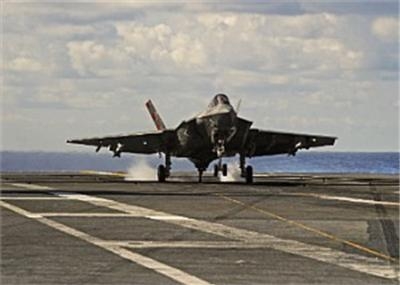Aircraft Fly From The Deck Of The USS George Washington
The jet blast from seven F-35C Lightning II Joint Strike Fighter aircraft only added to the already intense summer heat and humidity on the flight deck of USS George Washington (CVN 73), Aug. 15, where the third and final round of at-sea developmental testing, or DT-III, was underway about 100 miles offshore from Virginia.

During the 20-day testing period, which is set to conclude Sept. 1, objectives included external symmetric and asymmetric weapons loadings; launches and recoveries at maximum weight; approach handling qualities; landing systems certification; and engine logistics.
In addition to phase three of shipboard developmental testing, jet after jet thundered on and off the deck as 12 instructors and pilots from Strike Fighter Squadron (VFA) 101, out of Eglin AFB in Florida, completed the Navy's first fleet carrier qualifications, with each pilot knocking out two touch-and-goes and 10 arrested landings.
"The work we did [during the two previous testing phases at sea] directly fed what VFA-101 was able to come out and do today," explained Tom Briggs, lead flight test engineer with the F-35 Lightning II Integrated Test Force (ITF) at Naval Air Station Patuxent River and recipient of the 2015 Department of the Navy Lead Tester of the Year award. "For those of us involved in the program for quite a while, it was incredibly gratifying to see them come out and use that work to start making this aircraft real and get it out to the fleet."
Cmdr. Ted "Dutch" Dyckman, Air Test and Evaluation Squadron (VX) 23 test pilot, landing signal officer, and squadron operations officer at Pax River, started out flying F/A-18 Hornets, moved to F/A-18 Super Hornets, and now flies the F-35C. This was his third ship trip and 50th trap -- and he has a definite favorite.
"I prefer the F-35," he said. "It's easy to fly, autopilot is nice, cockpit has good visibility, and mission systems make it easy to do your task."
One of the most difficult and hazardous tasks in naval aviation is landing on the deck of an aircraft carrier, something now made simpler by Delta Flight Path. Developed by Lockheed Martin after a lot of crosstalk and technology sharing with NAVAIR personnel, the semi-automated landing mode significantly helps lower a pilot's workload task.
"The control laws allow aircraft to fly a commanded glide slope," Dyckman said. "Before, you had to manually fly that path through the air. Now, at the push of a button, the airplane will tip over and fly that path. If I have a good approach behind ship, I can push one button. If there are deviations, I can make a correction. Other than that, I may not touch the stick at all during the approach, from the start until touchdown. Coming to the ship is as easy as landing on an airfield now and that enables us to spend less time training guys to land on the ship."
Other testing involved improved nighttime visibility for the aircraft's third generation helmet, which displays symbology right on the pilot's visor.
"I don't have to look down for a piece of info on one display, then to another display and correlate it all in my head; everything appears in the helmet," Dyckman said. "When I look out, even if I'm looking away from where I'm going, I can see my target information, airspeed, altitude, threats. With this airplane, I basically have a display with my aircraft in the center and it presents information for situational awareness."
Test pilot Lt. Cmdr. Daniel "Tonto" Kitts, officer in charge of the VX-23 test detachment, noted three things about the F-35C that excite him.
"The ability to bring the aircraft back aboard the ship safely the first time, every time for the most junior pilot to the most senior is one of its major advantages," Kitts said. "Also, the incorporation of its mission systems to the pilot and the fusion of that information is really going to make it a lethal tactical platform. Lastly, its ability to share that information with other assets in the fleet is going to help build the picture for the whole carrier strike group. Not to mention, we're bringing a stealthy airplane to the carrier decks for the first time."
DT-III was an incremental buildup on five years of work from the Pax River ITF team, beginning with the first aircraft's initial onshore catapult and arresting gear testing and ending with the hundreds of operational cats and traps that recently took place aboard Washington. Having completed the gross weights and load up testing necessary to provide the fleet with a full launch and recovery bulletin, it was the final phase of testing.
"This is the last time we're coming to a carrier for F-35 testing and support for Navy IOC (initial operational capability)," explained Cmdr. J. Ryan Murphy, director of Test and Evaluation/F-35 Naval Variants. "It was satisfying to watch [VFA-101] start to utilize the aircraft. After all, that's the point of all the years of work -- to equip and empower the fleet with the F-35C."
(Image provided with U.S. Navy news release)
 Airbus Racer Helicopter Demonstrator First Flight Part of Clean Sky 2 Initiative
Airbus Racer Helicopter Demonstrator First Flight Part of Clean Sky 2 Initiative Diamond's Electric DA40 Finds Fans at Dübendorf
Diamond's Electric DA40 Finds Fans at Dübendorf ANN's Daily Aero-Term (04.23.24): Line Up And Wait (LUAW)
ANN's Daily Aero-Term (04.23.24): Line Up And Wait (LUAW) NTSB Final Report: Extra Flugzeugbau GMBH EA300/L
NTSB Final Report: Extra Flugzeugbau GMBH EA300/L Classic Aero-TV: 'Never Give Up' - Advice From Two of FedEx's Female Captains
Classic Aero-TV: 'Never Give Up' - Advice From Two of FedEx's Female Captains



